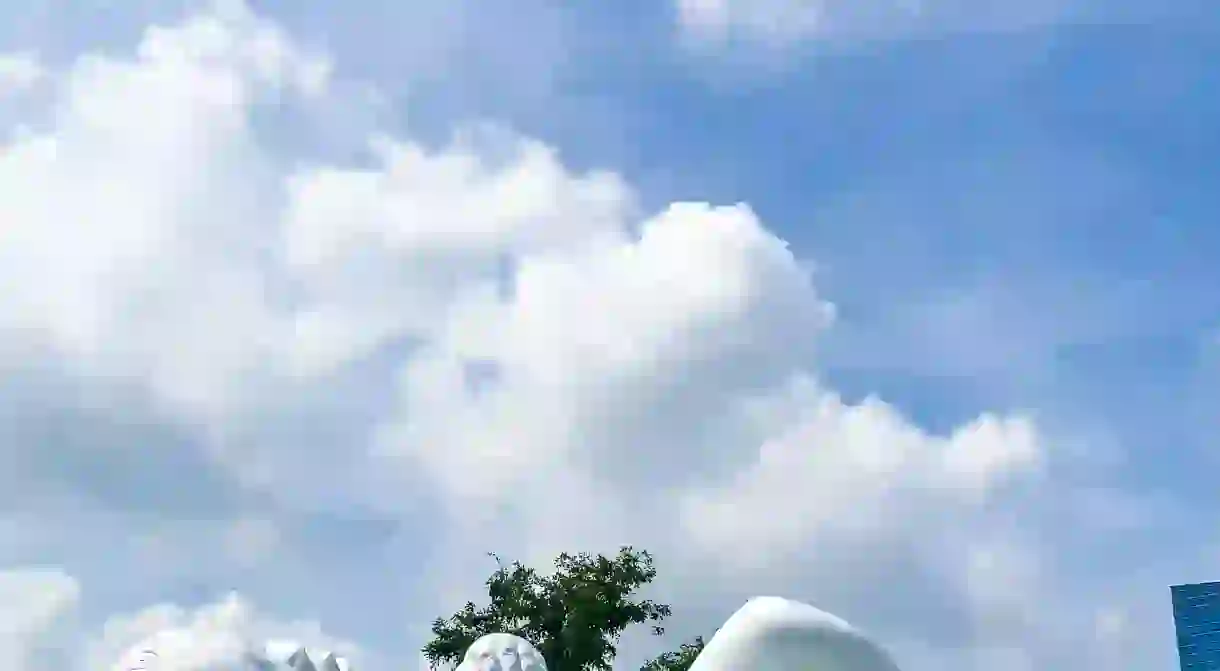The Best Public Art Installations and Sculptures in Singapore

Singapore’s streets are renowned for being clean and green, but look around and you’ll notice how much art there is along the sidewalks and pavements. Here are Culture Trip’s 10 favourite public art installations and sculptures that you can discover around Singapore.
Did you know – Culture Trip now does bookable, small-group trips? Pick from authentic, immersive Epic Trips, compact and action-packed Mini Trips and sparkling, expansive Sailing Trips.
First Generation by Chong Fah Cheong
Located on the banks of the Singapore River by the glitzy Fullerton Hotel, this bronze sculpture of joyful children leaping into the water is a slice of daily life from back in ‘the Little Red Dot’s’ early days. Sculpted in 2000 by esteemed Singaporean sculptor and Cultural Medallion award winner Chong Fah Cheong, it is one of four sculptures in a series known as People Along The River which are located nearby.
The Merlion by Lim Nang Seng

You might think this hybrid lion-fish creature an odd muse for artwork, but this symbol of Singapore is one of the most recognisable and popular tourist attractions in the city-state. The lion head stands for Singapore, known previously as Singapura or the Lion City, while the fishtail symbolises the country’s humble beginnings as a fishing village. There are actually seven Merlion statues in Singapore, but this eight-metre tall version at the Merlion Park near One Fullerton is the most famous, and is constantly photographed spouting water into Marina Bay. This Merlion statue was unveiled in 1972 and faces east for optimal feng shui.
Bird by Fernando Botero
Most office workers have walked by this fat, rounded bronze bird statue at the open-air United Overseas Bank plaza since its inauguration in 1990 – but few know that it was sculpted by famous Colombian artist Fernando Botero. Representing peace and optimism, the ‘fat bird’ (as it is known colloquially) is just one of several similar statues found around the world, including Botero’s hometown Medellin and at the airport in Florence, Italy.
Planet by Marc Quinn
Planet by acclaimed British sculptor Marc Quinn is probably better known to locals as ‘that giant floating baby’ at The Meadow in Gardens by the Bay. This nine-metre-long, seven-tonne bronze sculpture is a depiction of Quinn’s own infant son Lucas. Created in 2008, it only found its permanent home in Singapore after it was donated to the Gardens in 2013. Planet is the largest of over 40 artworks that can be found around the gardens – so you’ll struggle to miss it.
Kinetic Rain by Art+Com

Singapore’s Changi Airport consistently tops the list as one of the world’s best, and many head to Terminal 1 specifically to catch the mesmerising performance of the Kinetic Raindrops. Consisting of 1,216 bronze droplets suspended by individual strings from the departure hall ceiling, the raindrops dance in slow fluid movements to form various three-dimensional shapes above passing commuters. The sculpture has proven so popular that the airport commissioned German design company ART+COM for a new kinetic piece for Terminal 4 called ‘Petalclouds’.
Nutmeg and Mace by Kumari Nahappan
Look out for the giant two-tonne nutmeg seed sculpture prominently located in front of Ion Orchard, one of Singapore’s most luxurious shopping centres. The sculpture is a callback to the area’s history as an orchard and plantation, where nutmeg was one of the key crops that helped catapult Singapore’s economy. The bronze sculpture was created in 2009 by Singaporean artist Kumari Nahappan, who has several other local flora-inspired sculptures located around the city.
24 Hours in Singapore by Baet Yeok Kuan
It looks like a giant alien dropped five metal marbles on the front lawn of the Asian Civilisations Museum, but step closer to these reflective spheres and you will find yourself immersed in a 24-hour soundscape of everyday Singaporean life: from the sounds of the MRT to the local wet market. This interactive audio sculpture was created in 2015 in commemoration of Singapore’s 50 years of independence by Singaporean artist Baet Yeok Kuan – who intended for this artwork to serve both as a time capsule and a fun interactive playground.
Mother and Child by Ng Eng Teng
Mother and Child actually consists of two abstract sculptures by the late Dr Ng Eng Teng, a prominent Singaporean sculptor and esteemed Cultural Medallion winner, whose work deals with humanist themes presented with a whimsical flair. The first work (created in 1980) stands along Tanglin Road in front of the Orchard Parade Hotel, while the second work (created in 1996) is currently on display in Tampines Central Park. The latter has since been acquired by Singapore’s National Collection of visual art and will move to the National Gallery in 2019.
Rain Oculus by Ned Kahn
Walk along the waterfront promenade of the Marina Bay Sands and you’ll see a 22-metre-wide vortex of water swirling right in the middle of the sidewalk. Known as the Rain Oculus, this work was created as both a skylight and rain collector. Water flows at 6,000 gallons per minute and looks like a waterfall when viewed from the basement levels of the shopping complex. It was created by American artist Ned Kahn in collaboration with the architect of the Marina Bay Sands himself, Moshe Safdie.
All the Essentially Essential by Tan Wee Lit
Created in 2013 by Singaporean artist Tan Wee Lit, this fun interactive piece is his commentary on the life of the average Singaporean aspiring towards finding work-life balance. Located right in the heart of Singapore’s Central Business District at One Raffles Place, this stainless steel sculpture looks like a giant toy kit consisting of various items representing the essential items needed, like a computer and briefcase for work, and a gym bag and pet dog for play. The art piece deliberately leaves room for the audience to create the most essential component – the actual person – by leaving a space where people can insert themselves into the artwork.













